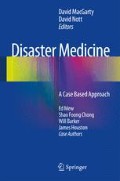Abstract
Having completed your GP training you decide to deploy and you take a post working in a large camp for people displaced following an earthquake. Given the total destruction of health and sanitation facilities you are unsurprised that disease is rife in the camp. One day a young girl is brought to you by her mother. She is dehydrated having produced a large quantity of watery diarrhoea in the previous 6 h. You send a sample off for investigation. Before the result returns your health centre becomes inundated with similar cases. The sample returns positive for Vibrio cholerae.
An epidemic ensues and you endeavour to manage the patient swell in a country unaccustomed to cholera and unprepared for an epidemic.
Reviewed by Daniele Lantagne
Access this chapter
Tax calculation will be finalised at checkout
Purchases are for personal use only
References
Walton DA, Ivers LC. Responding to cholera in post-earthquake Haiti. New England Journal of Medicine. 2011;364:3–5.
“We’ve been forgotten”: Conditions in Haiti’s displacement camps eight months after the earthquake, 2010, Joint report from University of San Francisco, Institute for Justice and Democracy in Haiti and The LAMP for Haiti Foundation. (http://ijdh.org/wordpress/wp-content/uploads/2010/09/IDP-Report-09.23.10-compressed.pdf).
Ananda Pokhrel. 2003. How to promote measures to prevent water-borne diseases, Nepal Water for Health in: IRC International Water and Sanitation Centre library (Assessed in 2011 at: http://www.irc.nl/page/8904).
Lever D, Soffer E. 2010. Acute Diarrhea, Cleveland Clinic: Center for Continuing Education (Assessed in 2011 at: http://www.clevelandclinicmeded.com/medicalpubs/diseasemanagement/gastroenterology/acute-diarrhea/).
WHO. International Health Regulations, 1969, Third annotated edition; 1983 (http://whqlibdoc.who.int/publications/1983/9241580070.pdf).
Global Task Force on Cholera Control. Cholera outbreak: assessing the outbreak response and improving preparedness, WHO publications; 2010. (WHO reference number: WHO/CDS/CPE/ZFK/2004.4).
WHO heath topics: Cholera (www.who.int/topis/cholera/about/en/index.html).
Wachsmuth K, Blake PA, Olsvik O. Vibrio cholerae and cholera: molecular to global perspectives. Washington D.C.: ASM Press; 1994.
Guidelines for Cholera Control. Geneva: World Health Organization; 1993.
PAHO. Epidemiological alert: weekly update on the cholera situation. Epidemiological Week 8 (Feb 20-26 2011) published 17 Mar 2011.
Author information
Authors and Affiliations
Corresponding author
Editor information
Editors and Affiliations
Rights and permissions
Copyright information
© 2013 Springer-Verlag London
About this chapter
Cite this chapter
MacGarty, D. (2013). Cholera: An Infectious Waterborne Disease. In: MacGarty, D., Nott, D. (eds) Disaster Medicine. Springer, London. https://doi.org/10.1007/978-1-4471-4423-6_18
Download citation
DOI: https://doi.org/10.1007/978-1-4471-4423-6_18
Published:
Publisher Name: Springer, London
Print ISBN: 978-1-4471-4422-9
Online ISBN: 978-1-4471-4423-6
eBook Packages: MedicineMedicine (R0)

